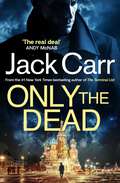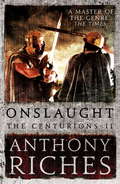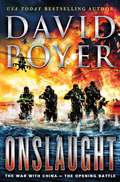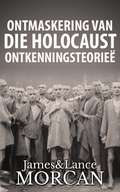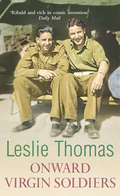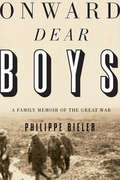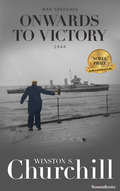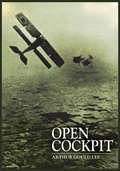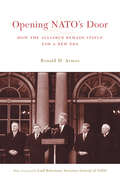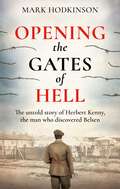- Table View
- List View
Only You
by R.F. EisenIn Only You, R.F. Eisen weaves a tale of love and commitment set against the backdrop of World War II. As the war rages on, two lovers, John and Ellen, find their lives torn asunder by chaos, casting seeds of doubt and despair.When a hurricane swamps the USS Warrington, knocking John Ridgeway- "Ridge" to his friends-and his fellow sailors overboard, their lives in imminent danger from sharks and exposure, John keeps faith by remembering the woman he left stateside. Meanwhile, Ellen, his new bride, awaits word from her beloved. The couple remain eager to embark upon a life together, yet world events keep them apart. Throughout their separation, Ellen and John encounter obstacles that a less resilient love could not endure. With meticulous historical detail, Only You immerses readers in a sweeping tale of courage, sacrifice, and the transcendent power of love that resonates for these troubled, modern times.
Only an Heiress Will Do (A Season to Wed)
by Virginia HeathFour soldiers face their greatest battle yet—the Regency marriage mart! Fall in love with the first installment of the Season to Wed miniseries. A marriage made in haste… Repented at leisure? Major Adam Mayhew has returned from war to discover his family facing ruin. He no longer cares for the expectations of the ton, but he needs a wealthy, convenient wife fast! Heartbroken by a scoundrel and with her reputation mud, Gwendolyn Trym agrees to use her sizable dowry to restore Adam&’s fortunes—and he can restore her good name! Then they can both dispense with the chore of marriage. Yet Adam is proving to be too clever, too rebellious and too attractive a husband…and Gwen's plan starts to unravel! From Harlequin Historical: Your romantic escape to the past.A Season to WedBook 1: Only an Heiress Will Do by Virginia HeathBook 2: The Viscount's Forbidden Flirtation by Sarah RodiBook 3: Their Second Chance Season by Ella MatthewsBook 4: The Lord's Maddening Miss by Lucy Morris
Only the Brave: A Novel
by Danielle SteelNEW YORK TIMES BESTSELLER • From #1 New York Times bestselling author Danielle Steel comes a powerful, sweeping historical novel about a courageous woman in World War II Germany.Sophia Alexander, the beautiful daughter of a famous surgeon in Berlin, has had to grow up faster than most young women. When her mother falls ill, Sophia must take charge of her younger sister, Theresa, and look after her father and the household, while also volunteering at his hospital after school. Meanwhile, Hitler&’s rise to power and the violence in her very own town have Sophia concerned, but only her mother is willing to share her fears openly.After tragedy strikes and her mother dies, Sophia becomes increasingly involved in the resistance, attending meetings of dissidents and helping however she can. Circumstances become increasingly dangerous and personal when Sophia assists her sister&’s daring escape from Germany, as Theresa flees with her young husband and his family. Her father also begins to resist the regime, secretly healing those hiding from persecution, only to have his hospital burned to the ground. When he is arrested and sent to a concentration camp, Sophia is truly on her own, but more determined than ever to help.While working as a nurse with the convent nuns, the Sisters of Mercy, Sophia continues her harrowing efforts to transport Jewish children to safety and finds herself under surveillance. As the political tensions rise and the brutal oppression continues, Sophia is undeterred, risking it all, even her own freedom, as she rises to the challenge of helping those in need—no matter the cost.In Only the Brave, Danielle Steel vividly captures the devastating effects of war alongside beautiful moments of compassion and courage.
Only the Brave: July 1944--The Epic Battle for Guam (American War Heroes)
by Don KeithFor Dutton Caliber's American War Heroes series, a World War II narrative on the American liberation of Guam in 1944, focusing on the twenty days of intense combat as the Marine Corps took the island back from the Japanese.On July 21, 1944, a US Marine division landed on the beaches of Guam, a once sleepy island in the Pacific that had been seized from the Americans by the Japanese in the hours after Pearl Harbor. The Japanese would not be giving Guam up easily. The large enemy force defended the island viciously, punching holes through the American lines, attacking from the flanks, and eventually resorting to banzai suicide attacks. The fighting was bloody and brutal, every bit as deadly as Iwo Jima or Okinawa would be. Now, acclaimed author Don Keith offers up a compelling account of one of the toughest fights of the Pacific War, a battle that led to ten thousand American casualties and four Medals of Honor.
Only the Dead: James Reece 6
by Jack Carr**NOW AN AMAZON PRIME TV SERIES STARRING CHRIS PRATT** 'Take my word for it, James Reece is one rowdy motherf***er. Get ready!' CHRIS PRATT JAMES REECE IS BACK 1978, Rhode Island: A freshman senator is gunned down, sending shockwaves through Washington that are still reverberating over four decades later. Now: In a world on the brink of war, facing rampant inflation, political division and shocking assassinations, a secret cabal of global elites are ready to assume control. And with the world&’s most dangerous man locked in solitary confinement, the conspirators believe the final obstacle to complete domination has been eliminated. They&’re wrong. From the firms of Wall Street to the corridors of power in Washington, DC and Moscow, secrets from the past have an uncanny ability to rise to the surface, and with the odds stacked against him, James Reece is on a deadly mission generations in the making. But for a man on the warpath, odds are not important . . . Intoxicating and timely, Only the Dead cements Jack Carr as 'a rare gut-punch writer, full of grit and insight' (Gregg Hurwitz, New York Times bestselling author). Fans of Tom Clancy&’s Jack Ryan, Lee Child's Jack Reacher or Vince Flynn's Mitch Rapp will love the James Reece series!Praise for Jack Carr: 'A propulsive and compulsive series. Jack Carr&’s James Reece is the kind of guy you&’d want to have in your corner. A suspenseful and exhilarating thrill-ride. Jack Carr is the real deal' Andy McNab 'This is seriously good . . . the suspense is unrelenting, and the tradecraft is so authentic the government will probably ban it – so read it while you can!' Lee Child 'With a particular line in authentic tradecraft, this fabulously unrelenting thrill-ride was a struggle to put down' Mark Dawson 'Gritty, raw and brilliant!' Tom Marcus 'So powerful, so pulse-pounding, so well-written – rarely do you read a debut novel this damn good' Brad Thor 'Carr writes both from the gut and a seemingly infinite reservoir of knowledge in the methods of human combat. Loved it!' Chris Hauty 'A powerful, thoughtful, realistic, at times terrifying thriller that I could not put down. A terrific addition to the genre, Jack Carr and his alter-ego protagonist, James Reece, continue to blow me away' Mark Greaney 'Thrilling' Publishers Weekly
Only the Dead: James Reece 6
by Jack Carr**NOW AN AMAZON PRIME TV SERIES STARRING CHRIS PRATT** 'Take my word for it, James Reece is one rowdy motherf***er. Get ready!' CHRIS PRATT JAMES REECE IS BACK 1978, Rhode Island: A freshman senator is gunned down, sending shockwaves through Washington that are still reverberating over four decades later. Now: In a world on the brink of war, facing rampant inflation, political division and shocking assassinations, a secret cabal of global elites are ready to assume control. And with the world&’s most dangerous man locked in solitary confinement, the conspirators believe the final obstacle to complete domination has been eliminated. They&’re wrong. From the firms of Wall Street to the corridors of power in Washington, DC and Moscow, secrets from the past have an uncanny ability to rise to the surface, and with the odds stacked against him, James Reece is on a deadly mission generations in the making. But for a man on the warpath, odds are not important . . . Intoxicating and timely, Only the Dead cements Jack Carr as 'a rare gut-punch writer, full of grit and insight' (Gregg Hurwitz, New York Times bestselling author). Fans of Tom Clancy&’s Jack Ryan, Lee Child's Jack Reacher or Vince Flynn's Mitch Rapp will love the James Reece series!Praise for Jack Carr: 'A propulsive and compulsive series. Jack Carr&’s James Reece is the kind of guy you&’d want to have in your corner. A suspenseful and exhilarating thrill-ride. Jack Carr is the real deal' Andy McNab 'This is seriously good . . . the suspense is unrelenting, and the tradecraft is so authentic the government will probably ban it – so read it while you can!' Lee Child 'With a particular line in authentic tradecraft, this fabulously unrelenting thrill-ride was a struggle to put down' Mark Dawson 'Gritty, raw and brilliant!' Tom Marcus 'So powerful, so pulse-pounding, so well-written – rarely do you read a debut novel this damn good' Brad Thor 'Carr writes both from the gut and a seemingly infinite reservoir of knowledge in the methods of human combat. Loved it!' Chris Hauty 'A powerful, thoughtful, realistic, at times terrifying thriller that I could not put down. A terrific addition to the genre, Jack Carr and his alter-ego protagonist, James Reece, continue to blow me away' Mark Greaney 'Thrilling' Publishers Weekly
Only the River: A Novel
by Anne RaeffA family displaced by World War II finds a new home in Central America, only to watch their fortunes rise and fall on the back of a revolution—from the California Book Award silver medalist and Simpson Literary Prize finalist.Fleeing the ravages of wartime Vienna, Pepa and her family find safe harbor in the small town of El Castillo, on the banks of the San Juan River in Nicaragua. There her parents seek to eradicate yellow fever while Pepa falls under the spell of the jungle and the town’s eccentric inhabitants. But Pepa’s life―including her relationship with local boy Guillermo―comes to a halt when her family abruptly moves to New York, leaving the young girl disoriented and heartbroken.As the years pass, Pepa’s and Guillermo’s lives diverge, and Guillermo’s homeland slips into chaos. Nicaragua soon becomes engulfed in revolutionary fervor as the Sandinista movement vies for the nation’s soul. Guillermo’s daughter transforms into an accidental revolutionary. Pepa’s son defies his parents’ wishes and joins the revolution in Nicaragua, only to disappear into the jungle. It will take decades before the fates of these two families converge again, revealing how love, grief, and passion are intertwined with a nation’s destiny.Spanning generations and several wars, Only the River explores the way displacement both destroys two families and creates new ones, sparking a revolution that changes their lives in the most unexpected ways.
Onslaught: The Centurions II (The Centurions)
by Anthony RichesThe author of the bestselling Empire sequence continues his new trilogy: the epic story of the uprising of the Batavi in AD 69.'A master of the genre' - The TimesAD 69: The Rhine frontier has exploded into bloody rebellion, and four centurions who once fought in the same army find themselves on opposite sides of a vicious insurrection. The rebel leader Kivilaz and his Batavi rebels have humbled the Romans in a battle they should have won. The legions must now defend their northern stronghold, the Old Camp, from the enraged tribes of Germany, knowing that they cannot be relieved until the civil war raging to the south has been resolved. Can they defend the undermanned fortress against thousands of barbarian warriors intoxicated by a charismatic priestess's vision of victory?
Onslaught: The Centurions II (The Centurions)
by Anthony RichesThe author of the bestselling Empire sequence continues his new epic of the uprising of the Batavi in AD 88.The Rhine frontier has exploded into all-out war. Summoned back to their homeland by their new leader Kivilaz, the Batavi cohorts, so recently proud soldiers of Rome, find their lands transformed. All Roman influences have vanished after a battle in which two legions were humbled by the rebels, then chased away to lick their wounds in their fortress, the Old Camp. As the most experienced men in the Batavi army, the veteran soldiers are send south again alongside an army of warriors from the German tribes, tasked with spearheading the fight to destroy the Roman stronghold and remove the threat it poses to their homeland.Swiftly besieged and without little hope of relief, the defeated 5th and 15th Legions grimly defend an undermanned fortress against both the Batavi and their enraged barbarian German allies, united under the banner of the priestess Veleda. But a relief column under a driven Roman general is marching north with a burning need to restore Rome's pride - and the events that follow will determine the fate of both the Old Camp and Roman rule on the northern frontier.(P)2017 Hodder & Stoughton Limited
Onslaught: The Centurions II (The\centurions Ser.)
by Anthony RichesThe author of the bestselling Empire sequence continues his new trilogy: the epic story of the uprising of the Batavi in AD 69. The Rhine frontier has exploded into all-out war. The Batavi cohorts, so recently proud soldiers of Rome, have returned to their homeland, summoned by their new leader Kivilaz: they will be the spearhead of an audacious assault on Roman power. Humbled by the rebels in a battle they should have won, the Romans retreat to their northern stronghold, the Old Camp, to lick their wounds. The 5th and 15th Legions grimly prepare to defend an undermanned fortress against both the Batavi and thousands of barbarian warriors intoxicated by a charismatic priestess's vision of their victory. Four centurions who once fought in the same army find themselves on opposite sides of a vicious civil war. For the Batavi, the prize could be freedom from Roman rule. For the Romans, the choices are victory or the most humiliating defeat their empire has ever known. And for one Batavi soldier, the greatest prize is simply survival in a battle with a cornered, desperate enemy.
Onslaught: The War with China--the Opening Battle (A Dan Lenson Novel #16)
by David PoyerThe sixteenth installment of the acclaimed Dan Lenson series, Onslaught chronicles Lenson's latest challenge: securing Taiwan, Korea, and Japan against the first phase of China's war for dominance of the Pacific. As the United States' computer, satellite, and financial networks are ravaged by coordinated digital attacks, China begins to conquer and disintegrate American allies in the Pacific, launching an invasion of Taiwan. The USS Savo, captained by Dan Lenson, is one of the few navy ships in place to contain China's air, sea, and land forces. With a fractured crew under attack from an unknown assailant aboard their own ship and facing missile launches from above and below the sea's surface, can Dan lead Savo into combat against an overwhelming enemy, or will the U. S. lose the Pacific--and perhaps much more--to China?The most explosive novel yet in the long-running Dan Lenson series, Onslaught begins an utterly convincing scenario of how global war with China might unfold.
Ontmaskering van die Holocaust Ontkenningsteorieë
by Elmarié Smal James Morcan Lance MorcanOntmaskering van die Holocaust Ontkenningsteorieë deur onafhanklike navorsers en filmmakers James Morcan & Lance Morcan met die voorwoord deur Holocaust oorlewende Hetty E. Verolme (skrywer van The Children's House of Belsen), is daarop gemik om uiteindelik die ontkenning vir eens en vir altyd te eindig, deur die bisarre verskynsel kop-teen-kop aan te pak. Geskryf in noue konsultasie met Holocaust oorlewendes en die Tweede Wêreldoorlog historici, is geen steen onaangeraak gelaat om die historiese feite van die volksmoord noukeurig te bevestig nie. Die Morcans bied 'n wye verskeidenheid van bronne aan, insluitend Nazi dokumentasie, ooggetuieverslae, wetenskaplike verslae en skokkende fotografiese bewyse; dit sluit ook in, debatte wat ontkenners wil skep. Een vir een, word hierdie verskillende argumente van die Holocaust ontkenners gebruik om dit te probeer diskrediteer met oorlog rekords wat noukeurig nagegaan is en dan dit stelselmatig as onjuis bewys. Teorieë wat ontmasker is, sluit die volgende in: die ses miljoen dodetalsyfer wat 'n oordrywing is; gaskamer uitwissing wat fiktief is; Adolf Hitler en die Derde Ryk word verkeerdelik swartgesmeer is; die ontleding van die Holocaust rekords wat taboe is, as gevolg van spesifieke wette in Europa kriminaliseer ontkenners; “Euwel Sioniste” en Israel wat so magtig is dat hulle geskiedenis kan sensor. Die Holocaust word in die bladsye van hierdie boek as een van die mees goed gedokumenteerde en die mees histories en forensies-beproefde misdade van die 20ste eeu te wees. In die proses het baie van die wêreld se mees berugte ontkenners, insluitend skandalige Britse historikus David Irving en die voormalige President van Iran, Mahmoud Ahmadinejad, geopenbaar dat hulle niks anders as anti-Semiete is wat op soek is na verdere swartsmering, ondermyning en demoralisering van die wêreld se Joodse bevolking. In hierdie insiggewende leesstof wat meer as twee millennia van global
Onward Virgin Soldiers
by Leslie ThomasBursting with life and bawdy humour, National Serviceman Brigg is now a Regular Army sergeant defending the Empire in the beds and bars of Hong Kong.Peace-time diversions include sensual fireworks with a pair of delicious Chinese twins and a tender, erotic affair with the lonely wife of an American serviceman.
Onward We Charge
by H. Paul JeffersThe true story of one of the most charismatic commanders of World War II. Awarded the Distinguished Service Cross and the Purple Heart, and posthumously promoted to Brigadier General by President Truman, Colonel William Darby was an indisputable hero. His elite battalion of Army Rangers paved the way for Ranger success in subsequent wars-and left an unforgettable legacy in its wake. Onward We Charge takes readers from the beachheads of North Africa to the bloody campaigns of southern Italy, and to Darby's tragic death by German shrapnel just eight days before V-E Day. This is the true story of a man who held his own beside the greatest military figures in history.
Onward, Dear Boys
by Philippe BielerThe Bieler family's vast collection of wartime letters and photographs tell intimate, firsthand stories of five young brothers and their parents. In Onward, Dear Boys, Philippe Bieler skilfully weaves together his own voice with those of his grandparents, his father, and his uncles into a story of war, immigration, and family life. Settling in the province of Quebec, then divided into French-speaking Catholics and English-speaking Anglicans, was a struggle for these devout, francophone Calvinists, but with the unexpected declaration of war in 1914 came an even greater challenge. In 1915 three of the five Bieler boys volunteered with the Princess Patricia Regiment, and in 1916 the fourth son followed. The eldest, Jean, became an assistant to Colonel Birkett, commander of the McGill-financed Canadian Hospital in Boulogne, and the second-eldest, Etienne, was promoted to lieutenant of an artillery brigade. The other two were privates who fought in battles including Sanctuary Wood, the Somme, Vimy, and Passchendaele, and in 1917, the fourth son, Philippe, died at the front. Upon their return to civilian life, the surviving brothers became leaders in government, science, and the arts : the eldest as Deputy Finance Director of the League of Nations, the second as a colleague of Sir Ernest Rutherford in the research of the atom, and the third as President of the Federation of Canadian Artists The youngest, Jacques, who was too young to go to war, was an instigator of the CCF party, a precursor to the NDP. Enlivened by a wealth of family archival material, Onward, Dear Boys is a poignant story of the experiences of war and its impact on a family of new Canadians during the first decades of the twentieth century.
Onward, Dear Boys: A Family Memoir of the Great War
by Philippe BielerThe Bieler family's vast collection of wartime letters and photographs tell intimate, firsthand stories of five young brothers and their parents. In Onward, Dear Boys, Philippe Bieler skilfully weaves together his own voice with those of his grandparents, his father, and his uncles into a story of war, immigration, and family life. Settling in the province of Quebec, then divided into French-speaking Catholics and English-speaking Anglicans, was a struggle for these devout, francophone Calvinists, but with the unexpected declaration of war in 1914 came an even greater challenge. In 1915 three of the five Bieler boys volunteered with the Princess Patricia Regiment, and in 1916 the fourth son followed. The eldest, Jean, became an assistant to Colonel Birkett, commander of the McGill-financed Canadian Hospital in Boulogne, and the second-eldest, Etienne, was promoted to lieutenant of an artillery brigade. The other two were privates who fought in battles including Sanctuary Wood, the Somme, Vimy, and Passchendaele, and in 1917, the fourth son, Philippe, died at the front. Upon their return to civilian life, the surviving brothers became leaders in government, science, and the arts : the eldest as Deputy Finance Director of the League of Nations, the second as a colleague of Sir Ernest Rutherford in the research of the atom, and the third as President of the Federation of Canadian Artists. The youngest, Jacques, who was too young to go to war, was an instigator of the CCF party, a precursor to the NDP. Enlivened by a wealth of family archival material, Onward, Dear Boys is a poignant story of the experiences of war and its impact on a family of new Canadians during the first decades of the twentieth century.
Onwards to Victory (Winston S. Churchill War Speeches #4)
by Winston S. ChurchillIn the fourth volume of the British prime minister&’s legendary wartime speeches, the tides are turning and an Allied victory is within reach. The brilliant politician and military strategist Winston S. Churchill was a master not only of the battlefield, but of the page and the podium. Over the course of forty books and countless speeches, broadcasts, news items and more, he addressed a country at war and at peace, thrilling with victory but uneasy with its shifting role in global politics. In 1953, he was awarded the Nobel Prize for Literature for &“his mastery of historical and biographical description as well as for brilliant oratory in defending exalted human values.&” During his lifetime, he enthralled readers and brought crowds roaring to their feet; in the years since his death, his skilled writing has inspired generations of eager history buffs. As WWII enters its final years and the US enters the fighting, an Allied victory is tantalizingly within reach. This period saw President Roosevelt&’s proposal of the &“unconditional surrender&” policy; the defeat of Mussolini and Rommel; Russia&’s dominance over Axis forces at Stalingrad; and a powerful new bombing campaign bringing the air conflict to the heart of Germany. Suddenly, victory seemed within the Allies&’ grasp. In this fourth volume of Churchill&’s famous wartime speeches, his stirring tone takes on an edge of hope and a glimmer of the triumph to come, as Britain rallied from the Blitz and readied itself for the final push.
Open Cockpit: A Pilot Of The Royal Flying Corps
by Arthur Gould LeeA riveting firsthand account of training for—and surviving—air combat during World War I, by the author of No Parachute. Thanks to a broken leg during flight school, Arthur Gould Lee gained valuable time flying trainers before he was posted in France during World War I. In November 1917 during low-level bombing and strafing attacks, he was shot down three times by ground fire. He spent eight months at the front and accumulated 222 hours of flight time in Sopwith Pups and Camels during a staggering 118 patrols, and engaged in combat 56 times. And yet he lived to retire from the RAF as an air vice-marshal in 1946. Lee puts you in the cockpit in this compelling personal account of life as a fighter pilot at the front. At turns humorous and dramatic, this thoughtful, enlightening memoir is a classic of military aviation.
Open Secret: The Autobiography of the Former Director-General of MI5
by Stella Rimington'The story of MI5's transformation - is fascinating. So, too is Rimington's account of her rise in what was very definitely a man's world.' Guardian____________________________The eye-opening memoir from the first female Director-General of MI5Stella Rimington worked for MI5 between 1969 and 1996, one of the most turbulent and dramatic periods in global history. Working in all the main fields of the Service's responsibilities - counter-subversion, counter-espionage and counter-terrorism - she became successively Director of all three branches, and finally Director-General of MI5 in 1992.She was the first woman to hold the post and the first Director-General whose name was publicly announced on appointment. In Open Secret, she continues her work of opening up elements of the work of our security services to public scrutiny, revealing the surprising culture of MI5 and shedding light on some of the most fascinating events in 20th century history from the ultimate insider viewpoint.____________________________Stella Rimington is also the author of the novels At Risk and Secret Asset.
Open When: Letters of Encouragement for Military Spouses
by Lizann LightfootA collection of encouraging, informative letters to read when facing the challenges of military life."... feels like a tight hug from a friend who gets it ..."—Becky Hoy, founder of Brave Crate, cofounder of PILLAR"... if you are a brand new military spouse ... or a seasoned military spouse, there is a letter in this book for you ..."—Brittany Boccher, 2017 AFI Military Spouse of the Year and founder of Discover Your SparkDear Military Spouse,I wrote these letters to encourage you throughout your military life journey. Whether you are celebrating a milestone, surviving an unfamiliar challenge, or feeling unheard, you are not alone.I am here with you, from the first moments of falling in love with your service member, to attending your first military ball, giving birth while your spouse is deployed, and moving across country (or an ocean) on short notice. I know what it's like to be making new friends—again and again, finding strength to support other spouses in the community, preparing to leave active duty, and many other military life moments in between.This collection of Open When letters is meant to deliver that special message from a friend who understands, whenever you need reassurance, helpful ideas, or a simple reminder of your own strength. We've got this!With love from a fellow military spouse,Lizann LightfootThe Seasoned Spouse"... Every letter in this book is unbelievably relatable to every chapter in my life as a military spouse ..."—Jen Pilcher, Navy spouse and founder of MilSpousefest"... The perfect gift for every military spouse in every walk of life. Truly a MUST READ."—Noralee Jones, writer and creator at Mrs. Navy Mama
Open When: Letters of Encouragement for Military Spouses
by Lizann LightfootA collection of encouraging, informative letters to read when facing the challenges of military life."... feels like a tight hug from a friend who gets it ..."—Becky Hoy, founder of Brave Crate, cofounder of PILLAR"... if you are a brand new military spouse ... or a seasoned military spouse, there is a letter in this book for you ..."—Brittany Boccher, 2017 AFI Military Spouse of the Year and founder of Discover Your SparkDear Military Spouse,I wrote these letters to encourage you throughout your military life journey. Whether you are celebrating a milestone, surviving an unfamiliar challenge, or feeling unheard, you are not alone.I am here with you, from the first moments of falling in love with your service member, to attending your first military ball, giving birth while your spouse is deployed, and moving across country (or an ocean) on short notice. I know what it's like to be making new friends—again and again, finding strength to support other spouses in the community, preparing to leave active duty, and many other military life moments in between.This collection of Open When letters is meant to deliver that special message from a friend who understands, whenever you need reassurance, helpful ideas, or a simple reminder of your own strength. We've got this!With love from a fellow military spouse,Lizann LightfootThe Seasoned Spouse"... Every letter in this book is unbelievably relatable to every chapter in my life as a military spouse ..."—Jen Pilcher, Navy spouse and founder of MilSpousefest"... The perfect gift for every military spouse in every walk of life. Truly a MUST READ."—Noralee Jones, writer and creator at Mrs. Navy Mama
Open for the Season
by Karl P. AbbottOpen for the Season, first published in 1950, is the entertaining, informative memoir by Karl Abbott of his family's long-time ownership and operation of hotels, inns, and resorts, from New Hampshire, to Boston, South Carolina, and Florida. Beginning with his childhood in his family's New Hampshire resort, The Uplands, Abbott would go on to manage or own popular hotels, inns, and resorts such as the Gasparilla Inn in Boca Grande, Florida, the Sagamore Resort in Lake George, New York, and the Hotel Vendome in Boston. Abbott paints a vivid picture of life at his properties, as well as providing insights into daily management, stories of his guests and workers, and what it took to be successful in the hotel business.
Opening NATO's Door: How the Alliance Remade Itself for a New Era (A Council on Foreign Relations Book)
by Ronald AsmusHow and why did NATO, a Cold War military alliance created in 1949 to counter Stalin's USSR, become the cornerstone of new security order for post-Cold War Europe? Why, instead of retreating from Europe after communism's collapse, did the U.S. launch the greatest expansion of the American commitment to the old continent in decades? Written by a high-level insider, Opening NATO's Door provides a definitive account of the ideas, politics, and diplomacy that went into the historic decision to expand NATO to Central and Eastern Europe. Drawing on the still-classified archives of the U.S. Department of State, Ronald D. Asmus recounts how and why American policy makers, against formidable odds at home and abroad, expanded NATO as part of a broader strategy to overcome Europe's Cold War divide and to modernize the Alliance for a new era.Asmus was one of the earliest advocates and intellectual architects of NATO enlargement to Central and Eastern Europe after the collapse of communism in the early 1990s and subsequently served as a top aide to Secretary of State Madeleine Albright and Deputy Secretary Strobe Talbott, responsible for European security issues. He was involved in the key negotiations that led to NATO's decision to extend invitations to Poland, Hungary, and the Czech Republic, the signing of the NATO-Russia Founding Act, and finally, the U.S. Senate's ratification of enlargement.Asmus documents how the Clinton Administration sought to develop a rationale for a new NATO that would bind the U.S. and Europe together as closely in the post-Cold War era as they had been during the fight against communism. For the Clinton Administration, NATO enlargement became the centerpiece of a broader agenda to modernize the U.S.-European strategic partnership for the future. That strategy reflected an American commitment to the spread of democracy and Western values, the importance attached to modernizing Washington's key alliances for an increasingly globalized world, and the fact that the Clinton Administration looked to Europe as America's natural partner in addressing the challenges of the twenty-first century.As the Alliance weighs its the future following the September 11 terrorist attacks on the U.S. and prepares for a second round of enlargement, this book is required reading about the first post-Cold War effort to modernize NATO for a new era.
Opening The Gates of Hell: The untold story of Herbert Kenny, the man who discovered Belsen
by Mark HodkinsonHerbert Kenny, an army dispatch rider, was the first Allied soldier to push open the gates at Belsen Concentration Camp, in April 1945. He kept his story from the world until an encounter with a trainee journalist brought it to light. Now, forty years on, that reporter is ready to share Herbert's incredible tale with the world. With unprecedented access to Herbert's diaries, letters and interviews, Mark Hodkinson brings to life the harrowing conditions of Belsen and its eventual liberation. From the events leading up to its gruesome discovery, to the trauma Herbert faced and his abandonment in the aftermath, this is a testament to the power of one person in the face of unimaginable darkness.This is the tale of an ordinary man thrown into an extraordinary, life-changing situation. How can a person cope when they come face-to-face with history's darkest moment? Herbert Kenny was that man. This is his story.'I have carried this story for many years, as Herbert did. I have written it because I owe it to him and others, the unknown and unsung, who, across many areas of life, have been burdened indiscriminately by great adversity and grief. They do really walk among us. And their grace, humility and strength is inspirational. While this is a tale of systematic malevolence, it is also about the resilience of the human spirit and a celebration of hope: there is more good than bad in the world, however it may sometimes seem.'
Opening The Gates of Hell: The untold story of Herbert Kenny, the man who discovered Belsen
by Mark HodkinsonHerbert Kenny, an army dispatch rider, was the first Allied soldier to push open the gates at Belsen Concentration Camp, in April 1945. He kept his story from the world until an encounter with a trainee journalist brought it to light. Now, forty years on, that reporter is ready to share Herbert's incredible tale with the world. With unprecedented access to Herbert's diaries, letters and interviews, Mark Hodkinson brings to life the harrowing conditions of Belsen and its eventual liberation. From the events leading up to its gruesome discovery, to the trauma Herbert faced and his abandonment in the aftermath, this is a testament to the power of one person in the face of unimaginable darkness.This is the tale of an ordinary man thrown into an extraordinary, life-changing situation. How can a person cope when they come face-to-face with history's darkest moment? Herbert Kenny was that man. This is his story.'I have carried this story for many years, as Herbert did. I have written it because I owe it to him and others, the unknown and unsung, who, across many areas of life, have been burdened indiscriminately by great adversity and grief. They do really walk among us. And their grace, humility and strength is inspirational. While this is a tale of systematic malevolence, it is also about the resilience of the human spirit and a celebration of hope: there is more good than bad in the world, however it may sometimes seem.'




